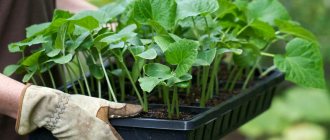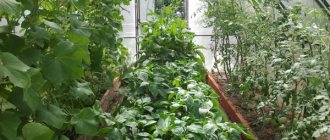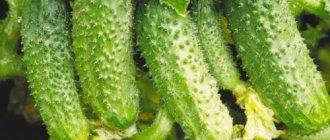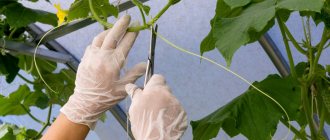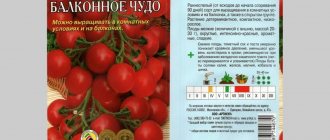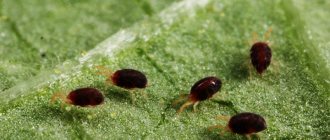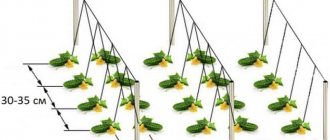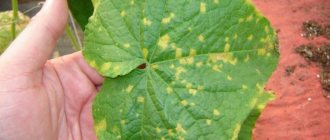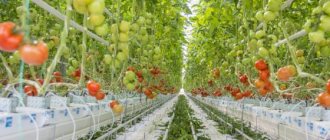Author's rating
Author of the article
Yakov Pavlovich
Professor, Head of the Department of Vegetable Growing
Articles written
153
Pollination is necessary for those plant crops that form male and female inflorescences. These species include cucumber. The pollination process is represented by the transfer of pollen from the stamens of male inflorescences to the pistils of female inflorescences. This leads to the formation of a root crop. To understand how to pollinate different varieties of cucumbers at home, you should familiarize yourself with the features of the procedure.
How to distinguish between male and female flowering types
Cucumber is considered a monoecious crop. This means that flowers of different sexes develop on the same bush. It is easy to distinguish them from each other:
- The male type of flowering is found in groups that are located closer to the base of the stem. Such inflorescences do not have pistils; they usually contain a sufficient amount of pollen. Trying to shake will result in a small dust cloud;
- female inflorescences have pistils. They develop in the area of lateral shoots. Their main difference from the male type is the presence of a thickening on the stem, which is similar to a small cucumber.
After the pollination process, a root crop is formed at the site of compaction.
Prevention of diseases and pests
Irrigation with cold water, lack of light, and contaminated soil lead to diseases. To avoid diseases and pests, it is recommended:
- Select large seeds for sowing and thoroughly disinfect them.
- Wash the planting container with baking soda in warm water.
- Disinfect the soil with a solution of potassium permanganate.
- Observe the regime of light and heat.
- Water the bushes only with warm and clean water.
- Pinch and shape plants in a timely manner.
- Treat cucumbers with Bordeaux mixture, wood ash solution, and whey.
- Regularly inspect the bushes for signs of disease: dry and yellow leaves, brown spots, white bloom.
If not properly cared for, indoor cucumbers develop powdery mildew. White spots appear on the leaves, which can be removed by spraying with Previkur. Another disease, copperhead, appears as deep brown spots on fruits and leaves. The copperhead cannot be treated; infected bushes and cucumbers are removed.
Whiteflies and aphids are dangerous pests. Miniature white insects reproduce quickly and settle on the inside of the cucumber leaf. Because of them, the bushes dry out and cucumbers lose their taste. A tobacco-based decoction helps get rid of pests.
Favorable conditions
In order to pollinate a plant crop on your own without bees, you should follow the recommended conditions:
- focus on air humidity. It should stay at the average level - 70%. At lower levels, pollen tends to dry out. High humidity levels can cause changes in the properties of genetic material;
- the temperature should be kept at an average level - no less than 14-15 degrees and no more than 25 degrees;
- The procedure is carried out in the first half of the day. Preferably early in the morning. Acceptable weather conditions - cloudy, calm;
- female inflorescences are treated 2 days after emergence. This guarantees correct and fruitful pollination;
- If it is necessary to pollinate a plant using the varietal method, the flowers are temporarily covered so that insects do not have access to them. To do this, use a thin film.
Bushes on which flowers have self-pollinated need to be covered or marked. But first check that the process was successful. Hand pollination, although considered difficult, is widely used by many summer residents when growing cucumbers in open and closed ground. Such root crops are obtained as varietals. This means you can collect seeds from them and not worry about yield indicators. In addition, artificial pollination helps to obtain selected and large root crops with a juicy taste.
How to plant
Seeds are most often sprouted in pots or paper cups. To fill them, peat is added to sawdust in a ratio of 1:3 and mixed with vermicompost. The acidity level of the mass is desirable in the region of 6-6.5, and the depth of the holes is 2 cm. If you maintain the temperature at 24-25°C, seedlings will become noticeable after a week. They are not watered for a couple of days after their appearance. Growing full-fledged seedlings will take 25 days.
Paper and plastic containers are suitable for germinating seeds.
Soil prepared in autumn and spring:
- pour a hot solution of potassium permanganate, pink;
- Cover with film for 3 days;
- open and form a bed with holes arranged in a checkerboard pattern. The depth of each should be equal to the height of the glass with seedlings, and a little fertilizer is placed at the bottom.
Seedlings are placed not only in a regular bed, but also in a potato “pie”. The peel of the starchy vegetable is dried and ground, and before planting the cucumbers, it is soaked in plain water. The resulting mixture is poured into the hole, sprinkled with earth, and then the potato mixture is poured again. The shoots are planted in this “pie”.
Another reason for pale leaves is considered to be low soil temperature. Sometimes it is possible to correct the situation by watering with warm water with a small amount of potassium permanganate. To prevent the soil from cooling down during cold weather, it is recommended to warm up the air in the greenhouse.
Pale leaves on cucumbers
How to pollinate cucumbers at home
Manual pollination is a rather complex technique. The most suitable way is to collect pollen from one bush and treat the inflorescences on another with it. In the process, use a regular thin brush with soft bristles. It is desirable that it be made from natural fibers. How to pollinate cucumbers by hand yourself:
- Find the male flower and use a brush to remove the pollen from it with gentle movements.
- Transfer the material to the female flower, or rather to its pistil.
- Cover the treated branch with cotton wool or other available means.
- How to artificially process cucumbers in the second way:
- Find the male inflorescence and carefully cut it off using sharp scissors.
- Remove all petals with slow movements so as not to disturb the pollen material.
- Place the remaining portion into the female flower.
- Leave the structure until the ovary appears. Several male inflorescences can be used in the process.
- The manual procedure is carried out 2-3 times a week. You can stop when the ovaries begin to grow.
Watering on schedule
You will be interested to know that the real ancestors of the modern cucumber came from the jungle, and these fruits were very bitter. And all because they grew too crowded, and they ended up lacking either moisture or nutrients. Try to repeat this experiment on your own plot and with ordinary seeds - the result will be the same, believe me. Haven’t you ever bought beautiful, but very bitter cucumbers at the market?
Before flowering, water greenhouse cucumbers once every 5-7 days, and after flowering - every 2-3 days. After all, it is during this period that the fruits begin to “pour,” as people say. Normal watering of cucumbers in a polycarbonate greenhouse is 1-2 buckets per 1 m2. Even if you are very busy, still do not water the cucumbers with cold water - this will cause powdery mildew to appear on the leaves and the plants will die. Just don’t water the cucumbers with a hose - strong pressure will wash away the soil, and this, in turn, will damage the root system.
To prevent the plant from growing too actively upward and taking all the moisture and nutrients, just pinch it:
Rules for pollination in a greenhouse
To carry out the pollination process yourself in greenhouse conditions, it is worth remembering the following rules:
- It is better to carry out painstaking work on the 2nd day after the opening of the inflorescences;
- You must remember the acceptable level of humidity in the room is 75%. Lower or higher readings may harm the pollen being carried;
- In order for the male pollinator plant to contribute to the ovary, it is necessary to maintain suitable temperature conditions. The work is carried out at +20-25 degrees. If the indicators are too high, the pollen loses its reproductive properties. As the temperature decreases, slow formation of ovaries is observed;
- To obtain a productive harvest, you need to transfer pollen material from one bush to another (cucumbers must be of the same variety).
- The procedure is carried out every day for 2-3 weeks until strong ovaries are formed. If the required conditions (temperature, humidity, pollination method) are violated, all efforts may be in vain.
Attracting insects
The basis of the method is to attract bees to the greenhouse. Plants are sprayed with a sweet solution.
For this you will need:
- Warm water 1l.
- Honey, sugar or jam 1 tbsp. spoon.
- Boric acid 0.1 g.
It is necessary not only to attract the smell, but also to help them get into the greenhouse. To do this, open windows and doors. The main thing is not to the detriment of the room temperature and humidity.
If possible, you can have a whole family of bees. Position the hive so that it stands at a height of 40 cm, and is well warmed in the morning sun. Insects must be well oriented; first, they should get used to their surroundings. They are released into a warm greenhouse when there is nothing there yet. Over time, the bee colony will begin its work.
During the flowering of natural honey plants, they need to be provided with flight outside the greenhouse. To do this, a small window is made in the lid; it needs to be whitened around it, this will help the bees easier to find their way back to the hive.
If cucumbers are grown in early spring, then the house with the bees is placed in a greenhouse. If in warmer times, the hive is left outside, pressed closely against the wall of the greenhouse, providing them with unobstructed entry. The hole made in the wall is aligned with the entrance to the hive. So insects will fly around the greenhouse, fly out of it into the street, through the window on the roof.
How self-pollinating cucumbers are pollinated
To obtain a high-quality harvest, the seeds of parthenocarpic cucumbers are planted earlier than others (early spring). During the process of reproduction, genetic information is exchanged between inflorescences. This happens after pollen grains land on the stamens of other flowers. Self-pollination occurs in different ways: when the stigma of the bud touches the anthers, when pollen spills out of the anther and lands on the stigma. Most often, strong winds contribute to reproduction. Pollen material can fall both on flowers within one bush and on neighboring seedlings.
Self-pollinating varieties bring a large harvest; they are resistant to sudden temperature changes, strong winds and high humidity. Such cucumbers are distinguished by their good taste, large size, and preservation when transported over long distances.
What is pollination
Pollination is necessary for representatives of the flora that produce both female and male flowers. Cucumber is one of these plants. Pollination is the process of transferring pollen from the stamens of male flowers to the stigma of the female pistil, resulting in the formation of a fruit.
Pollination is necessary for fruit to form.
In nature, the role of pollinators is played by birds, insects, wind, and water. However, in gardening, sometimes there are cases when you have to resort to an artificial process. For example, when growing cucumbers in an enclosed space (in a greenhouse, on a balcony or windowsill). There is no question of the help of bees and wind in such conditions. Another reason is the desire to get pure varietal fruits and seeds. If several varieties of cucumbers are cultivated in a limited space, then you need to take control of the pollination process.
One of the most famous pollinators is the bee.
The essence of obtaining the ovary from a cucumber bush
Anyone who has grown cucumbers knows that the color often falls off without bearing fruit. But there's nothing wrong with that. The plant is simply designed in such a way that there are both female and male inflorescences on its stems. Male flowers are so-called empty flowers; they themselves do not produce a harvest, but they perform an important task - they pollinate female inflorescences, after which they wither and fall off. The pollinated flower bears fruit and produces a harvest.
Cucumber blossom: male (right) and female (left) flower
Every greenhouse grower who grows cucumbers will have to learn to distinguish between these two types of inflorescences. The male flower does not have a pistil, but it has a stamen, and when gently shaken, pollen falls out of it. But in the female one you can find an oblong process, which will later turn into a cucumber fruit.
Female and male type of flowering of cucumbers: what is it, how to distinguish
For the pollination process to be successful, you need to know several nuances.
When flowering, a cucumber plant produces male and female flowers. They have pronounced differences, and it is difficult to confuse them.
Cucumber is a monoecious plant, i.e. flowers of both types are formed on the same individual.
Male flowers are located closer to the base of the stem. As a rule, they form inflorescence groups of 5–7 pieces. These flowers are often called barren flowers.
Male flowers are arranged in clusters near the base of the stem
Female flowers are formed on the side shoots. They are single, at the base there is a seal similar to a small cucumber.
Air temperature and sun protection
Make sure that the soil temperature on the day of planting is not lower than 18°C. If it is lower, the seedlings may wither, and surviving specimens will have too weak a root system.
For the first week after planting cucumber seedlings, keep the temperature in the greenhouse at 20-22°C. Exactly a week later, when new leaves appear and the root system begins to grow, reduce the temperature to 18-20°C. Note that some modern hybrids of this tropical vine already feel good at 16°C.
A prolonged cold spell with an air temperature of 8-10°C will lead to the death of the plant, and at a temperature of 3-4°C this will happen in just three days. Even at a depth of 20 cm, the soil in the greenhouse should be no colder than 20°C.
But when the first fruits begin to set, it is important not to allow the temperature in your cucumber greenhouse to rise above 18°C. The fact is that heat always stimulates the growth and development of a plant, and in the heat, cucumber fruits begin to grow too quickly, fiercely fighting for their moisture and nutrients
As a result, they are distributed unevenly, and the plant itself ages prematurely.
That is why a too long sunny day is also not a joy for a cucumber - the plant will set a lot of fruits and quickly get tired. There's a reason cucumbers that haven't been shaped grow like a jungle - they don't actually like direct sunlight. Therefore, if the sun is a frequent visitor in your region, throw a sun protection net over the greenhouse or whiten the glass with chalk. If the nights in the greenhouse are cold, be sure to cover the cucumbers, and on hot days shade them on the south side.
How to pollinate cucumbers at home
Pollination is best done in the morning, before lunch.
- Unopened buds should presumably be isolated a day before blooming - cover the flower with gauze or a paper cap. This must be done so that random insects do not interfere with the process. There should be 2 times more male flowers participating in the procedure than female ones.
For plants with larger flowers, such as melons, a clothespin is used to isolate the flower.
The corolla of the male flower is torn off and the pistil of the female flower is touched.
A brush collects pollen from male flowers and transfers it to female flowers.
Video: how to pollinate cucumbers growing in an apartment
Tips for getting good results
- the best time for pollination is on the second day after the flower opens;
- humidity should be about 70% (at a low level the pollen dries out, at a high level it becomes heavy and sticky);
- temperature also matters. At 27 o C and above, pollen loses activity. A temperature of 10–15 o C inhibits the development of ovaries. Optimal indicators are 20–25 o C;
- for the beauty of the fruit and to preserve the purity of the variety, it is recommended to take pollen from one bush and transfer it to another;
- You shouldn’t stop at just pollination. You need to continue the procedure daily for a week.
Important secrets
You need to pollinate cucumbers on the windowsill for one reason - the result of the process will be the ovary, which will turn into juicy crispy fruits. To do this, it is necessary that pollen from male flowers gets onto female flowers.
Inexperienced gardeners with no experience will not be able to distinguish the sexual characteristics of inflorescences, because for them all flowers “look the same.” In fact, everything is simple - male flowers are usually located near the main stem and gather in small groups. Females most often grow singly; near each inflorescence there is a small long thickening, shaped like a tiny cucumber. It is by this process that you can ensure that a small fruit begins to develop and turns into a large, tasty green.
You can engage in this fascinating process both in winter and in spring - it all depends on when the vegetable seeds were sent to the ground. The sooner you pollinate cucumbers on the windowsill in a private house or apartment, the faster the plants will produce a harvest.
It is better to do pollination not on the day the inflorescences bloom, but after 20-24 hours, while trying to increase the humidity on the windowsill. This can be done either using a household spray bottle, or simply placing a wide bowl of water near the containers with plants - the evaporation will fill the air with much-needed moisture.
Most owners prefer to engage in this process in the winter in order to achieve an early harvest, but it is recommended to repeat the process for several months, this will allow you to enjoy the taste of your own crispy products for almost the entire season.
It is better not to pollinate during the day; the ideal time is early morning or evening hours. If the weather is cloudy outside, you can start an interesting activity during the day. When pollinating plants in bright sunlight, you should take care of the shade - you can use newspaper or a light curtain (tulle).
Using a brush
The easiest way to achieve the appearance of the ovary is to pollinate cucumbers at home with a brush. For plants growing on the windowsill, choose a small tool, but always with natural soft bristles. This brush is not cheap, but it will serve you reliably for many years.
Proceed in this order:
Arm yourself with a brush and carefully collect pollen from male flowers. Make sure there is a tiny bit of dry dust left on the bristles (usually a bright yellow shade). In this case, the brush must be absolutely dry, otherwise the pollen will remain on the bristles. Gently apply pollen to female cucumber buds. During the process, you can take pollen from the male flowers of one plant and pollinate the female flowers of other cucumber bushes - this will allow you to grow even, beautiful greens. Cover the processed flowers with “caps” made of paper. The next day, carefully examine all female inflorescences and remove the flaccid ones. Protective “caps” should be removed only after it is noticeable that the ovary is enlarging
The care does not change, but you can increase the amount of moisture during watering.
It is better not to remove male flowers, because pollen from them can be collected for several days. Only after they have begun to wither, remove them from the plant so that the cucumber bushes do not waste their energy and direct it only to increasing and ripening the fruits.
Resourceful owners of beds on window sills often use cotton swabs for pollination. It is not recommended to do this - the effectiveness is significantly reduced, a lot of pollen simply gets stuck in the cotton wool.
Simple method
To get crispy cucumbers at home, you don’t need any special skills or knowledge, because everything you need will be provided by the plant itself. For pollination, you only need flowers, and they must be both male and female.
Step by step process:
- Pull out the male inflorescence, which must be large and healthy, without spots or dry areas on the petals (often these indicate the presence of a disease).
- Remove all the petals, leaving only the pistil.
- Gently run your finger over the pistil and make sure there is a lot of pollen on it (it is clearly visible on the skin of the fingertip).
- Use a pestle to touch the stamens of a female flower, you can even rub them.
- If the cucumber bushes are generous with male flowers, the pistils can be left in the female inflorescences, this ensures that pollination takes place and the ovary begins to grow.
- To avoid repeating the process, the worked flowers can be marked using a thread.
You can visually familiarize yourself with the process by watching an interesting video about how to pollinate cucumbers. The educational video will give answers to questions that often arise during work.
Which varieties require pollination?
There are parthenocarpic hybrids - species that form fruits without pollination. True, they have no seeds.
In self-pollinating cucumbers, both the pistil and stamens are found in the same flower. They do not need artificial pollination. Such varieties are the most productive, since almost all flowers can bear fruit.
Bee-pollinated cucumbers are pollinated by bees. If there are no insects, then there will be no ovaries. Their peculiarity is that there are an order of magnitude more male flowers than female ones. It is these varieties that need help with pollination. Such cucumbers are considered more useful.
Photo gallery: variety of cucumber varieties
What to consider when choosing varieties and hybrids of cucumbers for the greenhouse
When choosing cucumbers for growing in a greenhouse, the following are taken into account:
- purpose of fruits;
- method of pollination;
- endurance in the shade;
- ripening time;
- productivity;
- seasonality;
- ripening period;
- resistance to pests and diseases.
Pollination type
Cucumbers according to the type of pollination can be:
- Parthenocarpic hybrids for greenhouses with predominantly female flowers. The fruits have almost no seeds.
- Self-pollinating varieties combine female and male flowers, which allows them to pollinate themselves.
- Insect-pollinated crops are used for professional greenhouses where the ceilings are retractable.
Growing time
Seedlings are ready for transplanting into a greenhouse at the age of 24–30 days. That is, from the expected planting date, you need to subtract 30 days for seedling growth and 7 days for strengthening; this date is optimal for planting seed to obtain seedlings.
Attention: When purchasing seeds, you need to study the packaging, where on the back there are recommendations on how to grow a specific variety in a greenhouse and planting dates.
Economic purpose
When purchasing seed material, you need to determine the purpose of the crop. According to the method of use, cucumbers are:
- Universal varieties.
- Pickling types. Used for canning.
- Salad varieties.
Attention: The purpose of cucumbers is indicated on the packaging. If this information is not available, the color of the thorns will help determine the use of the fruit.
Salad varieties have white spines, and the skin has a more delicate shade.
Sustainability
Cucumber varieties are distinguished by shade tolerance. Spring and summer species are light-loving; you can get a good harvest in a greenhouse only with sufficient lighting. And winter cucumbers can tolerate shade very well.
Frost resistance is the main condition for the northern regions. Even with thermal insulation in the greenhouse, some varieties of cucumbers may die when planted early, becoming infected with a fungus. Therefore, at the beginning of autumn, only frost-resistant species are planted.
What to do with barren flowers
The abundance of barren flowers on cucumber bushes indicates improper agricultural practices. It is possible that fresh (from last year’s harvest) unheated seeds were planted. Thickened crops and lack of light also contribute to the appearance of many male flowers.
The abundance of barren flowers indicates incorrect agricultural practices
To stimulate the formation of female flowers, you need to pinch the top. It’s better over 5-6 sheets, but higher is possible. This stimulates the growth of side shoots, which become the habitat of female flowers.
Another option is to slow down watering. When the plant wilts a little, irrigation is resumed. Such unfavorable conditions trigger a natural mechanism: the plant hurries to produce offspring and produces female flowers. After this event, it is necessary to compensate the cucumber for stress and feed it (0.5 kg of mullein per 10 liters of water, 1 tbsp. solution for the bush).
Artificial pollination of cucumbers is a completely simple procedure. Knowing how to do this correctly, you can get a big harvest. In addition, manual pollination will allow you to collect pure varietal seeds.
Variety selection and seed preparation
Not all varieties of cucumbers are suitable for growing in winter greenhouses
In order not to be disappointed with the result and get a decent harvest, when selecting a variety it is important to follow several rules
- In winter, there are no bees or other pollinating insects in the greenhouse, so self-pollinating (or parthenocarpic) varieties and hybrids should be chosen. When choosing bee-pollinated varieties, it is necessary to carry out pollination by hand, and also plant several roots of cucumbers with a male type of flowering - they will provide the necessary pollen.
Cucumbers for growing in winter must be self-pollinating. Natural light during the winter months is insufficient, and creating artificial light in a spectrum close to the sun is quite difficult. For this reason, light-loving plants will not produce a decent harvest in winter. Shade-tolerant varieties should be selected. Maintaining natural humidity in a winter greenhouse is quite difficult: heating dries out the air, and you have to moisten it with frequent watering or spraying. This creates fluctuations in humidity and creates conditions for the rapid development of diseases. You should choose varieties that are resistant to bacterial and viral infections and fungal rot. Shaping plants in a greenhouse is necessary - thickening of plantings leads to diseases
To make this task easier, it is worth paying attention to hybrids with limited branching - these do not produce long side branches, directing all their forces to the growth of the main stem. It is convenient to form them vertically, with a garter to the supports. Hybrid varieties of cucumbers for greenhouses
For guaranteed results, it is better to plant two or three varieties; The following hybrids meet all the described requirements:
- Cupid F1;
- Cheetah F1;
- Dynamite F1;
- Berendey F1;
- Garland F1;
- Courage F1;
- Ant F.
After purchasing seeds, it is necessary to prepare them - this will allow for uniform germination and uniform growth of seedlings, as well as simultaneous fruiting. Preparation consists of several stages.
Preparing cucumber seeds for sowing
Step 1: Seed calibration. Dilute a teaspoon of salt in a glass of cool water and put the seeds there for 10-15 minutes. The ones that emerge are removed - they will not sprout or will produce weak plants. In a winter greenhouse, it is not practical to waste time and space on them.
The remaining heavy seeds are washed in running water. Seeds can also be calibrated by size, choosing the smoothest and largest.
Seed calibration
Step 2. Disinfection. To prevent bacterial infections, selected seeds are dipped for 20-30 minutes in a bright purple solution of potassium permanganate or three percent hydrogen peroxide.
Treatment with potassium permanganate
Step 3. Treatment for fungal infections. For fungal rot, seeds are soaked for 2-3 hours in a Fitosporin solution, which is prepared according to the manufacturer’s recommendations indicated on the package. Wash and dry the seeds.
Treatment of seeds in Fitosporin solution
Step 4. Warm up. It is carried out to prevent viral diseases and increase female flowers on the plant. It is most convenient to warm up the seeds in a thermos - it maintains a constant temperature. Pour water with a temperature of +60°C into a thermos, put the seeds in there and keep them for 4-8 hours.
Warming seeds in a thermos
Step 5. Hardening
For winter greenhouses, it is important to grow plants that are resistant to temperature changes and short-term drops in case of severe frosts or interruptions in heating. The seeds are placed in a napkin, moistened and placed on a saucer
Hardening is carried out on the bottom shelf of the refrigerator at a temperature from 0°C to +2°C for 2 days.
Hardening of seeds
Step 6. Stimulation. This technique speeds up germination and activates plant immunity. Stimulation is carried out in a solution of the drug “Epin” or “Zircon” according to the instructions on the bag. A folk recipe gives good results: tear off an aloe leaf, cut it in half lengthwise, place the seeds on the cut, cover with the cut part and wrap it in a napkin. Leave it overnight and plant it in the morning without washing.
Stimulation of seeds in "Epin"
How to pollinate cucumbers at home
Growing garden crops in greenhouses and at home requires artificial pollination, cucumbers are no exception. The quantity and quality of grown cucumbers depends on the quality of pollination. Self-pollinating plants do not need outside help; bee-pollinating plants are helped by insects. When growing cultivated plants in greenhouses or at home, it is pointless to rely on their help; under such circumstances, the plant must be pollinated manually. There are several methods of manual pollination, each of them has its own individual characteristics.
Self-pollinating varieties
Many summer residents do not like to grow cucumbers of self-pollinating species. This is due to the fact that they have a taste uncharacteristic for the crop, light stress can reduce the yield of the bush, and the plants are dependent on changes in external growing conditions.
But despite this, pollinating the plants yourself is quite labor-intensive, so gardeners buy hybrid varieties. Most often this is:
- Zozulya.
- Emelya.
- Hermann.
- Millionaire.
- Summer resident.
- Dynamite.
Experienced gardeners advise using a specific planting scheme for cucumbers when growing in greenhouse conditions. The very first to be planted are early hybrids of self-pollinating varieties. The majority of crops in a greenhouse should be insect-pollinated plants. The last to be planted are mid-ripening cucumber species.
Growing cucumbers at home in this way will protect the summer resident from loss of harvest.
Why is pollination required?
All representatives of the flora need pollination. The formation of fruits occurs as a result of the interaction of pollen from male stamens with the stigma of female ones. Pollinators for cucumbers in the wild are insects (mainly bees), birds, and wind. Sometimes situations arise when artificial pollination is required. This is necessary, as a rule, when cultivating cucumber crops in a limited and enclosed space (in greenhouse conditions, a greenhouse, on an apartment balcony) or if you want to obtain clean planting material and varietal fruits.
Why is pollination required?
Differences between male and female flowering types
It is important to understand the color on the plant. The main differences between female and male flowers:
- The female flower has a pistil. It is located, as a rule, on the side shoots. It has a thickening that visually resembles a miniature cucumber.
- The male flower does not have pistils, but they contain a large amount of pollen. If you shake it carefully, a whole cloud will form around it. They are located at the base of the stem, grouped in several pieces.
How to pollinate cucumbers at home
Pollinating cucumbers at home is not difficult if you first familiarize yourself with all the features. How to pollinate cucumbers in a greenhouse and at home:
- Unopened buds should be protected several days before they are expected to open. It is recommended to use a paper cap and gauze for this. This must be done so that insects do not land on the bush. There should be several times more male buds than female ones.
- Male flowers open for only one day, after which they fade. Female flowers take twice as long to pollinate. A day later, the gauze with paper caps is removed, and the so-called barren flowers are cut off. It is necessary to carefully cut off the corolla petal and attach it to the pistil of the female flower.
- You can “plant” pollen using a small brush with soft bristles. Pollen is attached to its bristles and transferred to the female flower.
- One female flower should be treated with 2-3 male flowers.
Important: pollination of cucumbers at home should be carried out in the morning, before lunch.
Optimal conditions for fruitful pollination
The crop must be pollinated in accordance with the following recommendations:
- Indoor humidity levels play a very important role in pollination. The optimal value is 70%. At low humidity, pollen dries quickly, and at high humidity, it sticks together.
- Pollination should be carried out in the first half of the day, no later than lunch.
- Female flowers are capable of pollination on the second day; it is at this time that the procedure is recommended.
- If you plan to carry out varietal pollination, it is advisable to cover the inflorescences from unwanted penetration of insects.
- Self-pollinating flowers need to be marked somehow.
- Temperature is of great importance for growing cucumbers. At temperatures above +27 degrees, pollen loses its activity. When the temperature drops to +10-15 degrees, the development of the ovary slows down. The optimal temperature is 20-25 degrees above zero.
- You should not limit yourself to one procedure; artificial pollination must be repeated every day for a week.
- In order for beautiful fruits to grow, pollen must be transferred to a nearby growing bush, and not to the same one.
Please note: many gardeners wonder whether bee-pollinated cucumbers can be planted in a greenhouse. It is possible, but only if the summer resident is ready to carry out pollination on his own.
Which varieties do not require pollination?
Scientists, through numerous experiments and studies, have obtained parthenocarpic hybrids that do not require pollination. This is an undeniable advantage of the species, but it also has a drawback - the fruits do not contain seeds that can be used as planting material for the next year.
The flowers of parthenocarpic hybrids contain both a pistil and a stamen (hermaphrodite). Such crops do not need pollination; they are more productive. Their advantageous feature is that each flower is capable of bearing fruit.
Main features of cucumbers
All varieties of this crop are divided into two categories: self-pollinating and cucumbers that require pollination by insects.
In the first species, the female number of peduncles predominates, which with their pollen are able to pollinate the pistils on their own flowers without outside participation. The second category is not capable of autonomously setting fruit, since the plants bear the majority of male non-productive flowers. To form the ovary, such varieties of cucumbers are pollinated with the help of insects and bees or artificially. Pollination occurs by moving from the male flower to the female peduncle.
Difference between female and male cucumber flowers
Of course, the best option for planting cucumbers is self-pollinating, hybrid species, but there are some subtleties here too. Active formation of ovaries can only occur in comfortable conditions. At the slightest stress, plants stop forming ovaries and shed existing ones.
Self-pollinating cucumbers in a greenhouse
Each cucumber variety has a division into male and female. Self-pollinating, mostly hybrid species have flowers of both sexes: pistil and stamen. Due to self-fertilization, such varieties are able to germinate well and there are much more ovaries on the bushes.
Self-pollinating cucumbers in a greenhouse
When growing vegetable crops in greenhouse conditions, you should not rely on natural pollination, and therefore self-pollinating cucumbers are the best choice for a greenhouse. There is an opinion that greenhouse cucumbers are significantly inferior in taste to ground varieties, but this is absolutely not the case.
It all depends on the right variety. Each type has its own specific purpose and differs in external and taste characteristics, which include:
- Very early ripening cucumbers, which are long, thin, not dense skin and juicy tender pulp.
- Mid-season varieties are distinguished by a special rich cucumber taste. Since the taste data and the rigidity of the texture are precisely balanced.
- Late varieties are tough, they have some dryness and quite often a slight bitterness.
Cucumbers in a greenhouse Cucumbers grown in greenhouse conditions are distinguished by early fruiting, high yield, excellent taste, as this is directly related to the absence of cold, wet weather and good greenhouse indicators of temperature and humidity. But cucumbers growing in a greenhouse cannot always do without bees, and you need to know how to pollinate the crop artificially.
Artificial pollination
Artificial pollination of cucumbers is not a very complicated procedure, but it is labor-intensive and requires not only knowledge, but also skill. Only by following precise recommendations can you achieve a good result.
Artificial pollination
- Pollination is carried out in the early morning before the onset of solar activity. In cloudy weather, you can start this procedure at any time.
- During the pollination period, the air humidity in the greenhouse should be about seventy percent. If the air is too dry, pollen will not germinate in the pistil. And in a very damp atmosphere it forms lumps.
- Artificial pollination should be carried out every other day, after the flower has fully bloomed. After a few days you will be able to see the result. Rapidly developing ovaries will appear on fertilized flowers.
- During this procedure, you should not forget to make notes on already pollinated flowers. In this case, one petal is torn off from an already fertilized flower.
It would seem that it is impossible to pollinate cucumbers without bees, but manual pollination carries out this process no worse than beneficial insects and it happens as follows:
- The corolla of the male inflorescence is torn off and brought to the female peduncle. The pollen that is shaken off should land directly on the pistil. This procedure should be carried out very carefully and, armed with a magnifying glass, examine the male flower. If all the pollen has flown around, you should continue this activity with other inflorescences.
- Pollen transfer can be done with a soft paint brush. With light movements, all the pollen is collected in a small container, and then transferred to the female inflorescences with the same brush. In this way, pollination is carried out much easier and faster without unnecessary loss of material.
Transfer of pollen by brush
When there is an interest in obtaining a high yield, pollination of cucumbers in the greenhouse should be carried out regularly. After several procedures, this activity will not seem so difficult.
